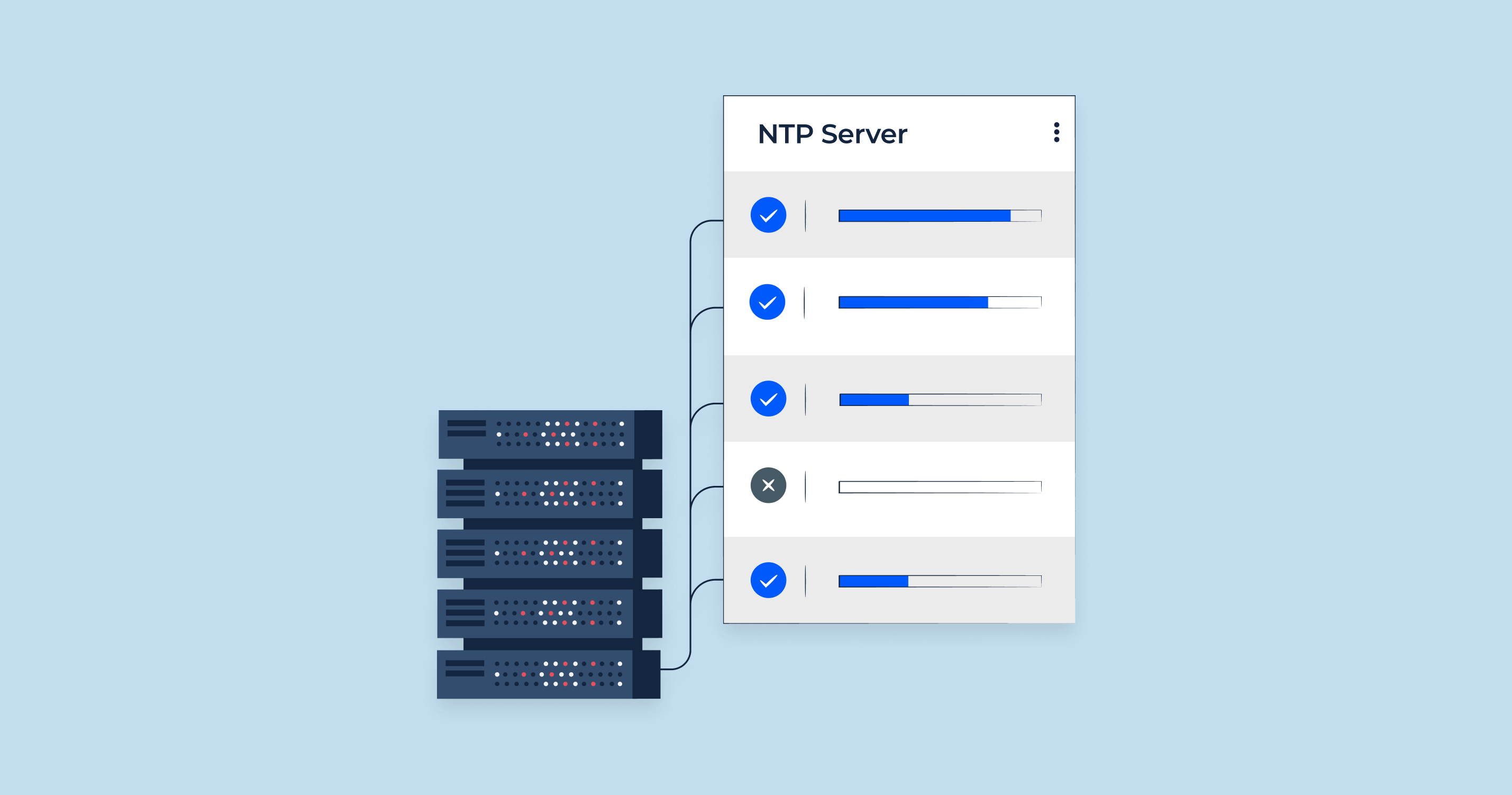What is an NTP Server?
The Network Time Protocol, commonly known as NTP, is a networking protocol designed to synchronize the clocks of computers over a network. First formulated in the 1980s, NTP is one of the oldest Internet protocols still in use today. Its primary aim is to ensure that the internal clocks of all systems on a network are consistent with each other, preventing discrepancies in time recordings, system logs, and other time-sensitive operations.
NTP operates by selecting a reference clock source, which is considered the authoritative time source, and then distributing this time across the network. Other devices or servers on the network adjust their internal clocks to match this reference, ensuring that time is kept consistent across all systems.
Why Is Time Synchronisation Important?
Time synchronization plays a critical role in many areas of modern computing and networking:
| Data Integrity | Many modern systems rely on timestamps to ensure the integrity of transactions. For instance, financial institutions need to precisely timestamp transactions to avoid fraud and maintain accurate records. |
| System Logs | Logs are essential for system troubleshooting, security monitoring, and performance tuning. Inconsistent timestamps can make it challenging to track events or detect security breaches. |
| Network Operations | Many network protocols rely on time-sensitive operations. Time synchronization ensures that packets and data are processed in the right order. |
| Distributed Systems | In systems where operations are spread across multiple servers, accurate time synchronization is crucial to ensure that processes occur in the correct sequence. |
| Legal and Compliance | Certain industries have regulations that require accurate time stamping for compliance, audit trails, and evidence. |
In essence, without synchronized time, there could be chaos in the digital world, leading to data loss, security vulnerabilities, operational inefficiencies, and legal complications.
What Is UTC and How Is It Decided?
Coordinated Universal Time, or UTC, is the world’s primary time standard. It’s the time against which all other time zones in the world are referenced, making it a cornerstone for global timekeeping.
UTC is not determined by the rotation of the Earth or its orbit around the Sun, as one might assume. Instead, it’s based on International Atomic Time (TAI), which is derived from more than 400 highly precise atomic clocks located in various laboratories around the world. These atomic clocks measure time based on the vibrations of cesium atoms, which are incredibly consistent.
However, because the Earth’s rotation is not perfectly regular and tends to slow down over time, occasional adjustments known as “leap seconds” are added to UTC. This ensures that UTC stays within 0.9 seconds of mean solar time, which is based on the Earth’s rotation.
The decision to add a leap second is made by the International Earth Rotation and Reference Systems Service (IERS), based in Paris. They monitor the Earth’s rotation and determine when it’s necessary to adjust UTC to ensure it remains close to mean solar time.
Deep Dive Into NTP
How Does NTP Work?
The Network Time Protocol (NTP) operates based on a hierarchical client-server model. At its core, NTP employs a system of time references, with each reference level defined in terms of “stratum.” The process begins with an authoritative time source and then distributes this time information to various layers of client devices and servers.
Here’s a step-by-step breakdown:
| Reference Clock Source | At the top, there is a reference clock source, typically an atomic clock or GPS clock, which is directly linked to a Stratum 0 device. This device is not used by NTP directly but serves as a reference for Stratum 1 servers. |
| Stratum 1 Servers | These are the primary NTP servers that are directly connected to Stratum 0 devices. They obtain time from the reference clock source and act as the primary time source for other devices on the network. |
| Stratum 2 Servers | These are secondary servers that sync their time with Stratum 1 servers. They can also communicate with other Stratum 2 servers to provide more resilient and redundant time services. |
| Stratum 3 Servers and Beyond | The hierarchy continues, with each subsequent stratum obtaining time from the level above. This can go on up to Stratum 15, as Stratum 16 is considered unsynchronized. |
| Time Synchronization Process | NTP uses a complex algorithm to determine the time delay and offset for each time request, considering factors like network latency. By analyzing these delays and offsets, NTP calculates the exact time adjustment needed for the requesting device. |
| Clock Adjustments | Once the offset is determined, the client device’s clock is adjusted slowly to avoid any drastic changes that might disrupt operations. If the offset is small, the clock might be sped up or slowed down until it aligns with the reference time. If the offset is significant, the time may be adjusted immediately. |
NTP Hierarchy: Stratum Levels Explained
NTP’s hierarchy is divided into different “stratum” levels, which indicate the distance from the reference clock source.
- Stratum 0: These are high-precision timekeeping devices such as atomic clocks, GPS, or radio clocks. They’re not part of the network but serve as reference devices for Stratum 1 servers.
- Stratum 1: These are primary time servers directly connected to Stratum 0 devices. They provide the primary time source for a network and are often located in universities, research labs, or large corporations.
- Stratum 2: These servers derive their time from Stratum 1 servers or other Stratum 2 servers. They can act as backup servers or distribute time to a wider audience.
- Stratum 3 and Beyond: Each subsequent stratum gets its time from the level directly above. As we move down the hierarchy, the precision decreases slightly due to factors like network latency and jitter.
A crucial point to note is that having multiple stratum levels allows for redundancy and resilience. If a Stratum 1 server goes offline, Stratum 2 servers synced with other Stratum 1 servers can still provide accurate time.
It’s also worth noting that while there can technically be up to 16 stratum levels (0-15), in practical applications, the hierarchy rarely goes beyond Stratum 3 or 4, as the time accuracy at lower stratum levels is usually sufficient for most applications.
Comparisons and Advanced Topics
What Is SNTP and How Is It Different?
Simple Network Time Protocol (SNTP) is a less complex version of the Network Time Protocol (NTP). While both are designed to synchronize the clocks of computers on a network, they serve different levels of needs in terms of accuracy and resource usage.
Differences between NTP and SNTP:
| Complexity | NTP uses complex algorithms to calculate time adjustments, taking into account factors like network latency, jitter, and clock drift. SNTP, on the other hand, is a simplified version that does not engage in the intricate computations that NTP does. It’s essentially a “once-off” time synchronization. |
| Accuracy | Due to its simplified nature, SNTP might not offer the same level of accuracy as NTP, especially over public networks with variable delays. |
| Resource Usage | Since SNTP doesn’t involve the rigorous computations of NTP, it’s less resource-intensive. This makes it ideal for simpler devices and systems where high precision is not a requirement. |
| Deployment Scenarios | SNTP is commonly used in devices like routers, switches, and some embedded systems where a rough synchronization is sufficient. NTP is used where high precision and accuracy are essential, like in data centers, financial systems, or research institutions. |
| Error Handling | NTP can manage multiple time sources, evaluate them, and handle errors or discrepancies much better. SNTP, when faced with conflicting time sources, might not handle the contradictions as gracefully. |
Public NTP Servers vs. Local NTP Servers
The choice between using public NTP servers and setting up local NTP servers depends on several factors, including the requirement for accuracy, network security, and the scale of the organization.
Public NTP Servers:
- Accessibility: Public NTP servers are available to anyone on the internet. Some popular public NTP pools provide time synchronization services to millions of users.
- Cost: They’re usually free to use, though heavy users or large organizations are encouraged to set up their servers to reduce the load on public ones.
- Reliability: While they’re generally reliable, there’s no guarantee of uptime, and sometimes they might be under heavy load, leading to decreased accuracy.
- Security Concerns: Using external servers can expose the internal network to potential threats. There’s also a possibility of time spoofing by malicious entities.
Local NTP Servers:
- Control: Organizations have full control over their local NTP servers, ensuring they’re configured correctly for their specific needs.
- Accuracy: With a local server, especially if connected to a high-precision time source like a GPS clock, the accuracy can be higher than relying on a public server over the internet.
- Security: Keeping time synchronization in-house reduces external security threats. There’s no need to allow external traffic for time synchronization, thus tightening the security perimeter.
- Network Load: Local NTP servers reduce the load on the organization’s internet connection, as synchronization requests stay within the local network.
- Cost: There’s an initial cost to set up and maintain local servers, but for large organizations, this can be offset by the benefits they provide.
For small organizations or individual users, public NTP servers might be sufficient. However, for larger organizations or those where precise time synchronization is crucial, setting up a local NTP server would be beneficial.
Implementation and Practical Use
How to Synchronise Your Network with an Internal NTP Server
Setting up an internal NTP server and synchronizing your network devices with it ensures accurate timekeeping across all systems. This section provides a step-by-step guide to achieve this.
Reference Clocks
Reference clocks are precise timekeeping devices, often atomic clocks or GPS clocks, providing an accurate time source.
- Selection: Choose a reliable reference clock. GPS-based reference clocks are popular due to their accuracy and widespread availability.
- Installation: Install the reference clock following manufacturer guidelines. For GPS clocks, ensure the GPS antenna has a clear view of the sky for satellite signals.
- Connectivity: Connect the reference clock to your NTP server using the recommended interface, typically serial or ethernet.
Time Receivers
Time receivers capture time signals from reference clocks and feed them into NTP servers.
- Integration: Ensure the time receiver is compatible with your reference clock source. Some receivers are built specifically for certain types of clocks.
- Configuration: Set up the time receiver to interpret signals correctly. For GPS, this might involve selecting the right satellite constellation or setting up correction methods.
- Connection: Connect the time receiver to the NTP server, ensuring data flows seamlessly between them.
Internal NTP Servers
Once you have the reference clock and time receiver set up, the next step is to configure your internal NTP server.
- Selection: Choose robust server hardware. The server doesn’t need to be overly powerful, but reliability is key.
- Installation: Install a server operating system and NTP software. Both Linux and Windows have NTP server capabilities, though Linux with the ntpd service is a common choice.
-
Configuration:
- Define the reference clock in the NTP configuration.
- Set up authentication if required, ensuring only authorized clients can sync with the server.
- Specify logging parameters for monitoring and troubleshooting.
- Testing: Once configured, test the NTP server’s functionality. Check if it’s getting accurate time from the reference clock and if it’s able to distribute this time to client devices.
NTP Clients
These are the devices on your network that will sync their clocks with the internal NTP server.
-
Configuration: On each client device:
- Specify the IP address of the internal NTP server.
- Set the sync frequency – how often the client should check and adjust its time.
- Configure authentication if set up on the server.
- Monitoring: Regularly monitor clients to ensure they’re syncing correctly. Tools and logs can help identify devices that are out of sync or facing issues.
-
Troubleshooting:If clients face issues:
- Check network connectivity to the NTP server.
- Ensure client configurations match server settings, especially if authentication is involved.
- Review client logs to identify specific errors or issues.
By following these steps, you can set up an efficient and accurate time synchronization infrastructure within your organization, ensuring all systems operate in harmony and with precision.
Related Concepts and Advanced Study
Related terms
To gain a comprehensive understanding of NTP, it’s essential to familiarize oneself with related terms and concepts:
- Stratum: Refers to the hierarchical level within the NTP network, dictating the distance from the reference clock source.
- Drift: The natural tendency of a clock to gain or lose time.
- Jitter: The variability of time measurements between NTP requests.
- Leap Second: An extra second added to UTC to account for Earth’s irregular rotation.
- Round-Trip Delay: The time taken for an NTP request to travel to the server and back.
Firewalls and their relation to NTP
Firewalls, which monitor and control incoming and outgoing network traffic, play a crucial role in the security of NTP implementations.
- NTP Traffic: By default, NTP uses UDP on port 123. Firewalls should be configured to allow this traffic for NTP synchronization.
- Security: Unauthorized NTP servers might send malicious time updates. Firewalls can restrict traffic to trusted NTP servers only.
- Rate Limiting: Firewalls can prevent NTP-based DDoS attacks by rate limiting NTP requests.
- Monitoring: Firewalls can log NTP traffic, assisting in monitoring and identifying unusual patterns that could indicate malicious activity.
The Open Systems Interconnect Model and NTP
The OSI Model is a conceptual framework used to understand network interactions in seven layers.
- Application Layer (Layer 7): This is where NTP operates, serving user requests and providing synchronization services.
- Transport Layer (Layer 4): NTP typically uses the UDP protocol, which operates at this layer, to handle its communications.
- Network Layer (Layer 3) and Below: While NTP doesn’t directly operate here, its efficiency and accuracy can be impacted by factors at these layers, such as network latency.
Understanding how NTP fits within the OSI Model can provide insights into its interaction with other network protocols and services.
Case Studies involving NTP
Exploring case studies can shed light on the practical applications, challenges, and importance of NTP.
- Financial Transactions: How stock exchanges rely on precise time stamps to sequence high-frequency trades and ensure fair trading.
- Network Failures: Investigating instances where incorrect time synchronization led to system outages, data inconsistencies, or security breaches.
- Scientific Research: Highlighting the role of precise timekeeping in experiments, data collection, and research projects.
- Legal and Forensics: Showcasing the importance of time stamps in digital evidence, CCTV footage, and other forensic investigations.
- Infrastructure Attacks: Examining cases where NTP servers were exploited in DDoS attacks or where malicious actors tried to manipulate time synchronization for nefarious purposes.
By delving into these related concepts and case studies, one can gain a more profound appreciation of NTP’s significance, intricacies, and its interactions with broader network and security systems.
Improved Algorithms for Synchronizing Computer Network Clocks
The accuracy and efficiency of NTP largely rely on the algorithms used for synchronization. Over the years, improvements have been made to these algorithms to optimize performance.
- Clock Filtering and Selection: Algorithms help in selecting the best clock source from multiple available options by analyzing the stability and reliability of each source.
- Clock Discipline Algorithms: Adjust the local clock in small increments to avoid abrupt changes and maintain a smooth time flow.
- Marzullo’s Algorithm: Used for selecting the optimal time source by aggregating responses from multiple servers and finding the smallest interval where the majority agree.
- Mitigating Network Delays: Advanced algorithms account for network delays, calculating the round-trip time, and adjusting accordingly.
Distributed Systems and NTP
Distributed systems consist of multiple interconnected computers working together as a unified system. Time synchronization in such systems is paramount.
- Event Ordering: Precise time stamps ensure events occurring across different machines can be accurately sequenced.
- Concurrency Control: Time synchronization prevents conflicts when multiple operations occur simultaneously.
- Data Consistency: Ensures that all nodes in a distributed database have a consistent view of the data.
- Fault Tolerance and Recovery: Accurate timekeeping helps in identifying failures and orchestrating recovery processes in a coordinated manner.
Recommended publications on NTP
For those seeking deeper knowledge on NTP, the following publications come highly recommended:
- “Computer Network Time Synchronization: The Network Time Protocol” by David L. Mills: A comprehensive guide on NTP’s history, design, and implementation.
- “NTP: The Network Time Protocol” by Uwe Doering: A practical guide that covers the setup, configuration, and management of NTP.
- IEEE publications: Various papers and articles discussing the technical intricacies, improvements, and future directions of time synchronization protocols.
- RFCs (Request for Comments): Official documents detailing the specifications, enhancements, and challenges of NTP.
SSH Server Advanced Use: Maintaining System Time
SSH (Secure Shell) servers provide a secure means of accessing and managing remote systems. While not directly related to NTP, maintaining system time is crucial for SSH operations.
- Log Integrity: Accurate time stamps in SSH logs ensure traceability and accountability of user actions.
- Session Management: Time synchronization helps in efficiently managing and timing out inactive SSH sessions.
- Certificate Validity: SSH relies on certificates for authentication. Time synchronization ensures the system recognizes valid certificates and rejects expired ones.
- Troubleshooting: Accurate timekeeping is vital when analyzing events leading up to an issue, especially in multi-server environments.
To maintain system time on an SSH server:
- Ensure the server is synchronized with a trusted NTP server.
- Regularly monitor for clock drifts and make necessary adjustments.
- Configure SSH logs to include precise time stamps for every action and event.
By understanding these advanced and related topics, one gains a deeper insight into the complexities and intricacies of time synchronization in modern computing environments.
Forensic Time: World NTP Servers
In the realm of digital forensics, the precise time of events is of paramount importance. World NTP Servers play a pivotal role in this.
- Digital Evidence: The timestamps on files, logs, and network packets can serve as critical evidence in legal cases. Their accuracy is ensured by synchronizing with trusted NTP servers.
- Incident Response: When a security incident occurs, investigators rely on accurate timestamps, often obtained through an incident response framework, to reconstruct the sequence of events and identify the root cause.
- World NTP Servers: These are authoritative time servers located globally, maintained by various organizations, and synchronized with atomic clocks or GPS signals. Examples include servers maintained by NIST in the USA and PTB in Germany.
- Trust and Security: In forensics, it’s vital to ensure that timestamps haven’t been tampered with. Using secure, authenticated NTP protocols and trusted world servers helps ensure time integrity.
The Communication View
Communication forms the backbone of NTP. It’s through messages and replies that clocks are synchronized.
Request-Reply Communication
The essence of NTP’s working is a request-reply mechanism:
- Request: An NTP client sends a timestamped request to an NTP server, asking for the current time.
- Server Processing: The server receives the request, logs the receipt time, and then sends a reply back to the client with both the receipt time and the server’s current time.
- Calculation: Using these timestamps and the time of reply receipt, the client can calculate the time difference and adjust its clock.
- Latency Compensation: The request-reply mechanism inherently accounts for network latency, ensuring accuracy in synchronization.
Using the NTP Client Within Distributed Systems
Distributed systems, consisting of multiple machines working together, rely on NTP clients for synchronization:
- Consistency: In systems where data replication is vital (like databases), NTP ensures that data written on one node is accurately timestamped and can be correctly ordered on other nodes.
- Coordination: For tasks that need coordination across machines (like job scheduling or load balancing), precise timekeeping is essential.
- Client Configuration: Each machine in a distributed system runs an NTP client. These clients may synchronize with an internal NTP server or external world servers, depending on system requirements and security considerations.
- Failover and Recovery: If a node in a distributed system fails and needs to be restored, accurate timekeeping ensures data integrity during the recovery process.
Understanding these aspects gives a clearer picture of the importance of time synchronization, not just for individual machines but for intricate, interconnected systems that drive today’s digital world.
Check DNS Records for Any Website With DNS Lookup by Sitechecker
The DNS Lookup tool by SiteChecker is an indispensable asset for anyone seeking insights into domain name server details. With a straightforward interface, users can effortlessly unravel crucial DNS information about any domain, aiding in troubleshooting or understanding server configurations better. This tool promises to deliver accurate, real-time data, making it a vital resource in the toolkit of web administrators and digital enthusiasts alike.

Delving deeper, the tool’s additional features are truly impressive. Not only does it provide a comprehensive breakdown of DNS records, but it also categorizes them—MX, TXT, A, CNAME, and more—for easier interpretation. Coupled with its rapid response time, the DNS Lookup tool offers a seamless experience, ensuring users can swiftly and effectively get the information they require.
Instant DNS Insight, One Click Away!
Our DNS Lookup tool offers a clear, detailed snapshot of all associated DNS records.
Conclusion
The precision and accuracy of timekeeping, driven by the Network Time Protocol (NTP), underscore its pivotal role in the fabric of modern digital systems. From facilitating consistent operations in distributed systems to ensuring the integrity of digital forensics, NTP’s influence is pervasive and undeniable. As we’ve explored, its reach extends beyond mere synchronization, intertwining with complex communication mechanisms, advanced algorithms, and critical cybersecurity protocols. As our reliance on interconnected systems continues to grow, so will the importance of NTP in underpinning their reliable and trustworthy operation. It’s a testament to the brilliance of its design that a protocol conceptualized decades ago remains so integral today, driving forward the relentless march of digital progress.









